Case Study Analysis: Leadership Report - MGMT 101, Semester 1
VerifiedAdded on 2022/10/17
|9
|2195
|11
Report
AI Summary
This report presents a case study analysis focusing on a leadership scenario, where Sam is facing challenges in motivating his team. The analysis delves into McGregor's Theory X and Y, recommending that Sam adopts Theory X due to the team's lack of motivation and disinterest. The report further suggests the application of Henri Fayol's five principles of management, including planning, organizing, commanding, coordinating, and controlling, to address the issues. Additionally, the report explores Maslow's hierarchy of needs to understand and address team member needs. The conclusion supports the suitability of Theory X in this context, and offers guidance to Sam to improve team dynamics and work performance.
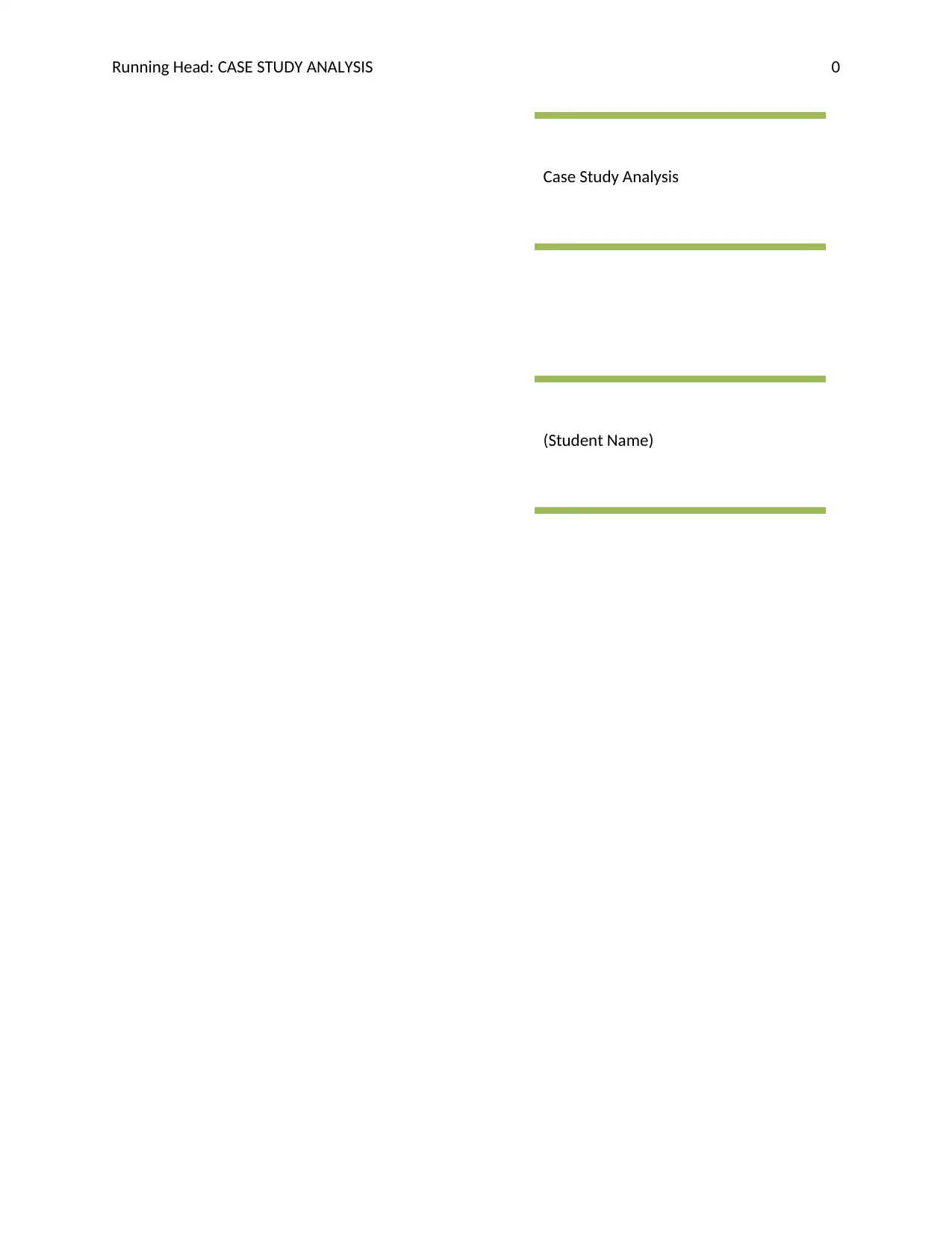
Running Head: CASE STUDY ANALYSIS 0
Case Study Analysis
(Student Name)
Case Study Analysis
(Student Name)
Paraphrase This Document
Need a fresh take? Get an instant paraphrase of this document with our AI Paraphraser

CASE STUDY ANALYSIS 1
Table of Contents
Introduction......................................................................................................................................2
Analysis of Case Study....................................................................................................................2
Recommendation.............................................................................................................................3
Concept and Theories......................................................................................................................5
Conclusion.......................................................................................................................................6
References........................................................................................................................................7
Table of Contents
Introduction......................................................................................................................................2
Analysis of Case Study....................................................................................................................2
Recommendation.............................................................................................................................3
Concept and Theories......................................................................................................................5
Conclusion.......................................................................................................................................6
References........................................................................................................................................7
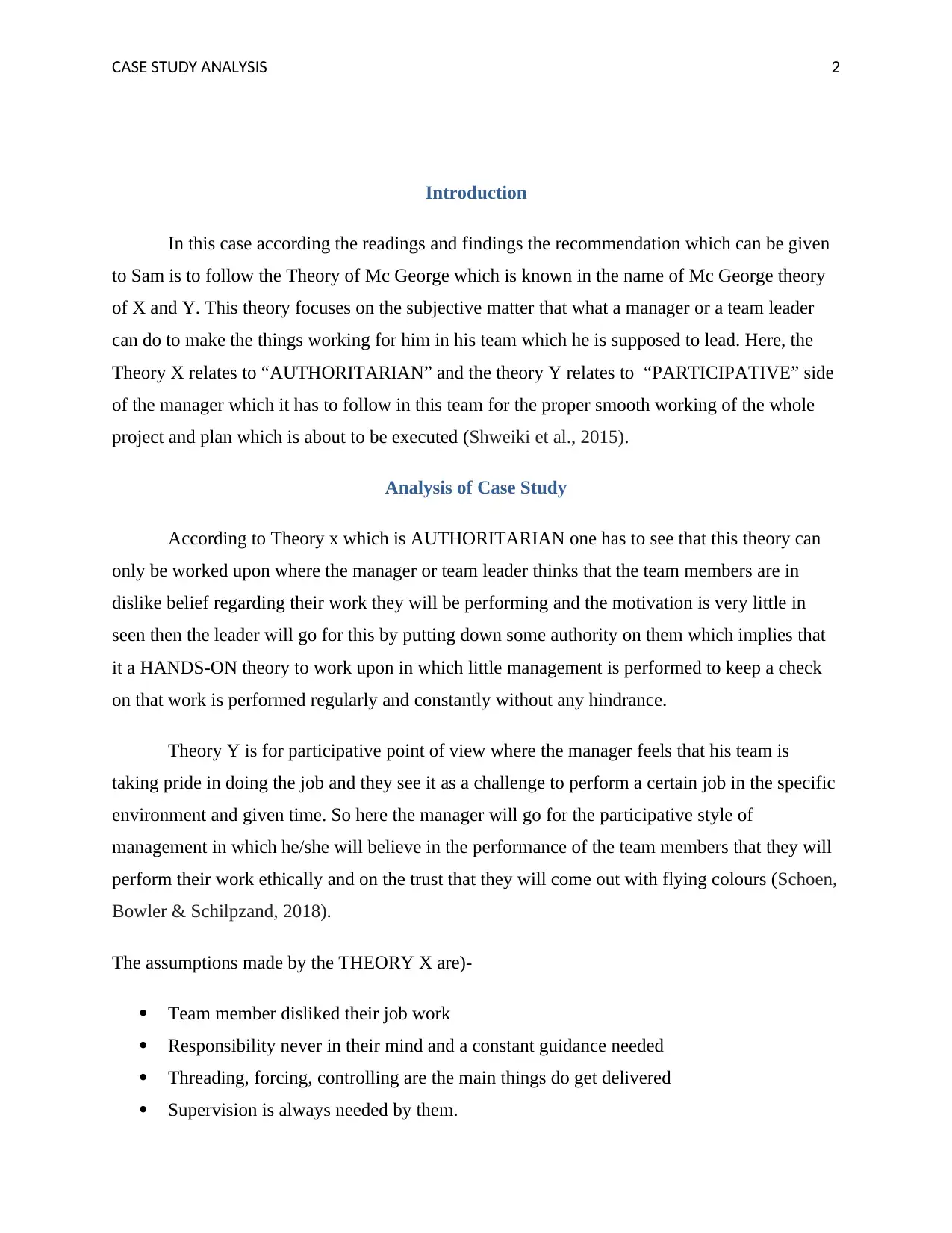
CASE STUDY ANALYSIS 2
Introduction
In this case according the readings and findings the recommendation which can be given
to Sam is to follow the Theory of Mc George which is known in the name of Mc George theory
of X and Y. This theory focuses on the subjective matter that what a manager or a team leader
can do to make the things working for him in his team which he is supposed to lead. Here, the
Theory X relates to “AUTHORITARIAN” and the theory Y relates to “PARTICIPATIVE” side
of the manager which it has to follow in this team for the proper smooth working of the whole
project and plan which is about to be executed (Shweiki et al., 2015).
Analysis of Case Study
According to Theory x which is AUTHORITARIAN one has to see that this theory can
only be worked upon where the manager or team leader thinks that the team members are in
dislike belief regarding their work they will be performing and the motivation is very little in
seen then the leader will go for this by putting down some authority on them which implies that
it a HANDS-ON theory to work upon in which little management is performed to keep a check
on that work is performed regularly and constantly without any hindrance.
Theory Y is for participative point of view where the manager feels that his team is
taking pride in doing the job and they see it as a challenge to perform a certain job in the specific
environment and given time. So here the manager will go for the participative style of
management in which he/she will believe in the performance of the team members that they will
perform their work ethically and on the trust that they will come out with flying colours (Schoen,
Bowler & Schilpzand, 2018).
The assumptions made by the THEORY X are)-
Team member disliked their job work
Responsibility never in their mind and a constant guidance needed
Threading, forcing, controlling are the main things do get delivered
Supervision is always needed by them.
Introduction
In this case according the readings and findings the recommendation which can be given
to Sam is to follow the Theory of Mc George which is known in the name of Mc George theory
of X and Y. This theory focuses on the subjective matter that what a manager or a team leader
can do to make the things working for him in his team which he is supposed to lead. Here, the
Theory X relates to “AUTHORITARIAN” and the theory Y relates to “PARTICIPATIVE” side
of the manager which it has to follow in this team for the proper smooth working of the whole
project and plan which is about to be executed (Shweiki et al., 2015).
Analysis of Case Study
According to Theory x which is AUTHORITARIAN one has to see that this theory can
only be worked upon where the manager or team leader thinks that the team members are in
dislike belief regarding their work they will be performing and the motivation is very little in
seen then the leader will go for this by putting down some authority on them which implies that
it a HANDS-ON theory to work upon in which little management is performed to keep a check
on that work is performed regularly and constantly without any hindrance.
Theory Y is for participative point of view where the manager feels that his team is
taking pride in doing the job and they see it as a challenge to perform a certain job in the specific
environment and given time. So here the manager will go for the participative style of
management in which he/she will believe in the performance of the team members that they will
perform their work ethically and on the trust that they will come out with flying colours (Schoen,
Bowler & Schilpzand, 2018).
The assumptions made by the THEORY X are)-
Team member disliked their job work
Responsibility never in their mind and a constant guidance needed
Threading, forcing, controlling are the main things do get delivered
Supervision is always needed by them.
⊘ This is a preview!⊘
Do you want full access?
Subscribe today to unlock all pages.

Trusted by 1+ million students worldwide
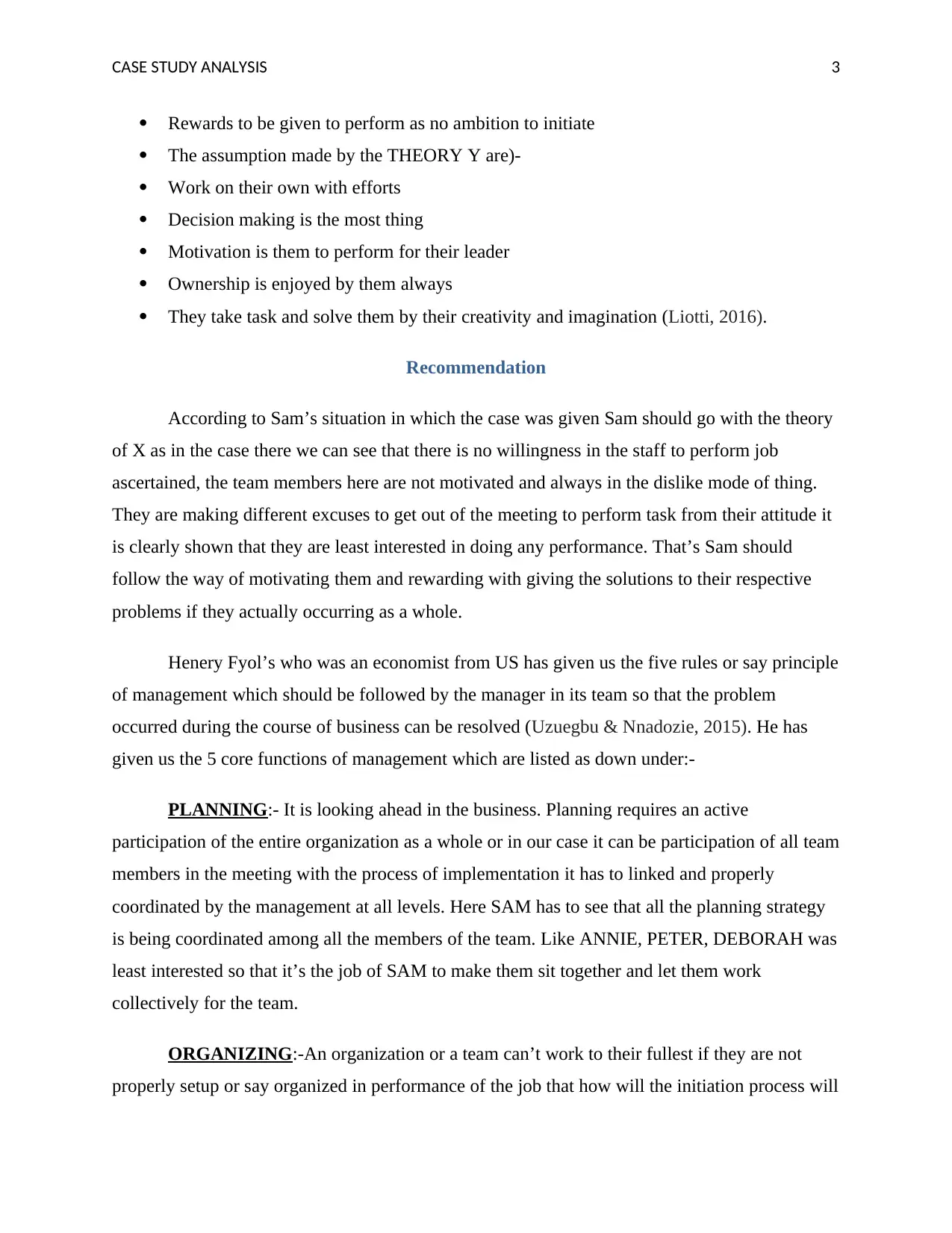
CASE STUDY ANALYSIS 3
Rewards to be given to perform as no ambition to initiate
The assumption made by the THEORY Y are)-
Work on their own with efforts
Decision making is the most thing
Motivation is them to perform for their leader
Ownership is enjoyed by them always
They take task and solve them by their creativity and imagination (Liotti, 2016).
Recommendation
According to Sam’s situation in which the case was given Sam should go with the theory
of X as in the case there we can see that there is no willingness in the staff to perform job
ascertained, the team members here are not motivated and always in the dislike mode of thing.
They are making different excuses to get out of the meeting to perform task from their attitude it
is clearly shown that they are least interested in doing any performance. That’s Sam should
follow the way of motivating them and rewarding with giving the solutions to their respective
problems if they actually occurring as a whole.
Henery Fyol’s who was an economist from US has given us the five rules or say principle
of management which should be followed by the manager in its team so that the problem
occurred during the course of business can be resolved (Uzuegbu & Nnadozie, 2015). He has
given us the 5 core functions of management which are listed as down under:-
PLANNING:- It is looking ahead in the business. Planning requires an active
participation of the entire organization as a whole or in our case it can be participation of all team
members in the meeting with the process of implementation it has to linked and properly
coordinated by the management at all levels. Here SAM has to see that all the planning strategy
is being coordinated among all the members of the team. Like ANNIE, PETER, DEBORAH was
least interested so that it’s the job of SAM to make them sit together and let them work
collectively for the team.
ORGANIZING:-An organization or a team can’t work to their fullest if they are not
properly setup or say organized in performance of the job that how will the initiation process will
Rewards to be given to perform as no ambition to initiate
The assumption made by the THEORY Y are)-
Work on their own with efforts
Decision making is the most thing
Motivation is them to perform for their leader
Ownership is enjoyed by them always
They take task and solve them by their creativity and imagination (Liotti, 2016).
Recommendation
According to Sam’s situation in which the case was given Sam should go with the theory
of X as in the case there we can see that there is no willingness in the staff to perform job
ascertained, the team members here are not motivated and always in the dislike mode of thing.
They are making different excuses to get out of the meeting to perform task from their attitude it
is clearly shown that they are least interested in doing any performance. That’s Sam should
follow the way of motivating them and rewarding with giving the solutions to their respective
problems if they actually occurring as a whole.
Henery Fyol’s who was an economist from US has given us the five rules or say principle
of management which should be followed by the manager in its team so that the problem
occurred during the course of business can be resolved (Uzuegbu & Nnadozie, 2015). He has
given us the 5 core functions of management which are listed as down under:-
PLANNING:- It is looking ahead in the business. Planning requires an active
participation of the entire organization as a whole or in our case it can be participation of all team
members in the meeting with the process of implementation it has to linked and properly
coordinated by the management at all levels. Here SAM has to see that all the planning strategy
is being coordinated among all the members of the team. Like ANNIE, PETER, DEBORAH was
least interested so that it’s the job of SAM to make them sit together and let them work
collectively for the team.
ORGANIZING:-An organization or a team can’t work to their fullest if they are not
properly setup or say organized in performance of the job that how will the initiation process will
Paraphrase This Document
Need a fresh take? Get an instant paraphrase of this document with our AI Paraphraser
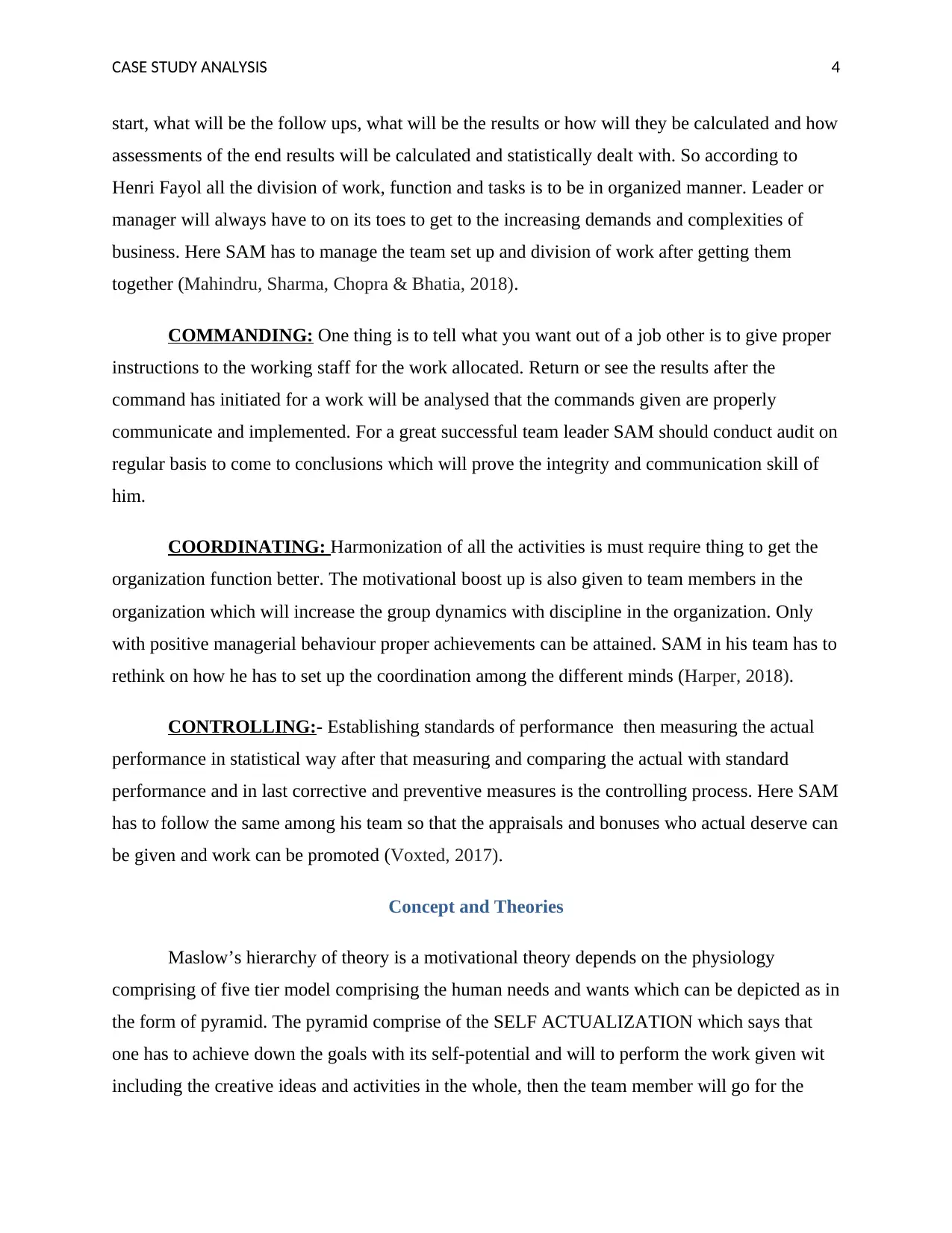
CASE STUDY ANALYSIS 4
start, what will be the follow ups, what will be the results or how will they be calculated and how
assessments of the end results will be calculated and statistically dealt with. So according to
Henri Fayol all the division of work, function and tasks is to be in organized manner. Leader or
manager will always have to on its toes to get to the increasing demands and complexities of
business. Here SAM has to manage the team set up and division of work after getting them
together (Mahindru, Sharma, Chopra & Bhatia, 2018).
COMMANDING: One thing is to tell what you want out of a job other is to give proper
instructions to the working staff for the work allocated. Return or see the results after the
command has initiated for a work will be analysed that the commands given are properly
communicate and implemented. For a great successful team leader SAM should conduct audit on
regular basis to come to conclusions which will prove the integrity and communication skill of
him.
COORDINATING: Harmonization of all the activities is must require thing to get the
organization function better. The motivational boost up is also given to team members in the
organization which will increase the group dynamics with discipline in the organization. Only
with positive managerial behaviour proper achievements can be attained. SAM in his team has to
rethink on how he has to set up the coordination among the different minds (Harper, 2018).
CONTROLLING:- Establishing standards of performance then measuring the actual
performance in statistical way after that measuring and comparing the actual with standard
performance and in last corrective and preventive measures is the controlling process. Here SAM
has to follow the same among his team so that the appraisals and bonuses who actual deserve can
be given and work can be promoted (Voxted, 2017).
Concept and Theories
Maslow’s hierarchy of theory is a motivational theory depends on the physiology
comprising of five tier model comprising the human needs and wants which can be depicted as in
the form of pyramid. The pyramid comprise of the SELF ACTUALIZATION which says that
one has to achieve down the goals with its self-potential and will to perform the work given wit
including the creative ideas and activities in the whole, then the team member will go for the
start, what will be the follow ups, what will be the results or how will they be calculated and how
assessments of the end results will be calculated and statistically dealt with. So according to
Henri Fayol all the division of work, function and tasks is to be in organized manner. Leader or
manager will always have to on its toes to get to the increasing demands and complexities of
business. Here SAM has to manage the team set up and division of work after getting them
together (Mahindru, Sharma, Chopra & Bhatia, 2018).
COMMANDING: One thing is to tell what you want out of a job other is to give proper
instructions to the working staff for the work allocated. Return or see the results after the
command has initiated for a work will be analysed that the commands given are properly
communicate and implemented. For a great successful team leader SAM should conduct audit on
regular basis to come to conclusions which will prove the integrity and communication skill of
him.
COORDINATING: Harmonization of all the activities is must require thing to get the
organization function better. The motivational boost up is also given to team members in the
organization which will increase the group dynamics with discipline in the organization. Only
with positive managerial behaviour proper achievements can be attained. SAM in his team has to
rethink on how he has to set up the coordination among the different minds (Harper, 2018).
CONTROLLING:- Establishing standards of performance then measuring the actual
performance in statistical way after that measuring and comparing the actual with standard
performance and in last corrective and preventive measures is the controlling process. Here SAM
has to follow the same among his team so that the appraisals and bonuses who actual deserve can
be given and work can be promoted (Voxted, 2017).
Concept and Theories
Maslow’s hierarchy of theory is a motivational theory depends on the physiology
comprising of five tier model comprising the human needs and wants which can be depicted as in
the form of pyramid. The pyramid comprise of the SELF ACTUALIZATION which says that
one has to achieve down the goals with its self-potential and will to perform the work given wit
including the creative ideas and activities in the whole, then the team member will go for the
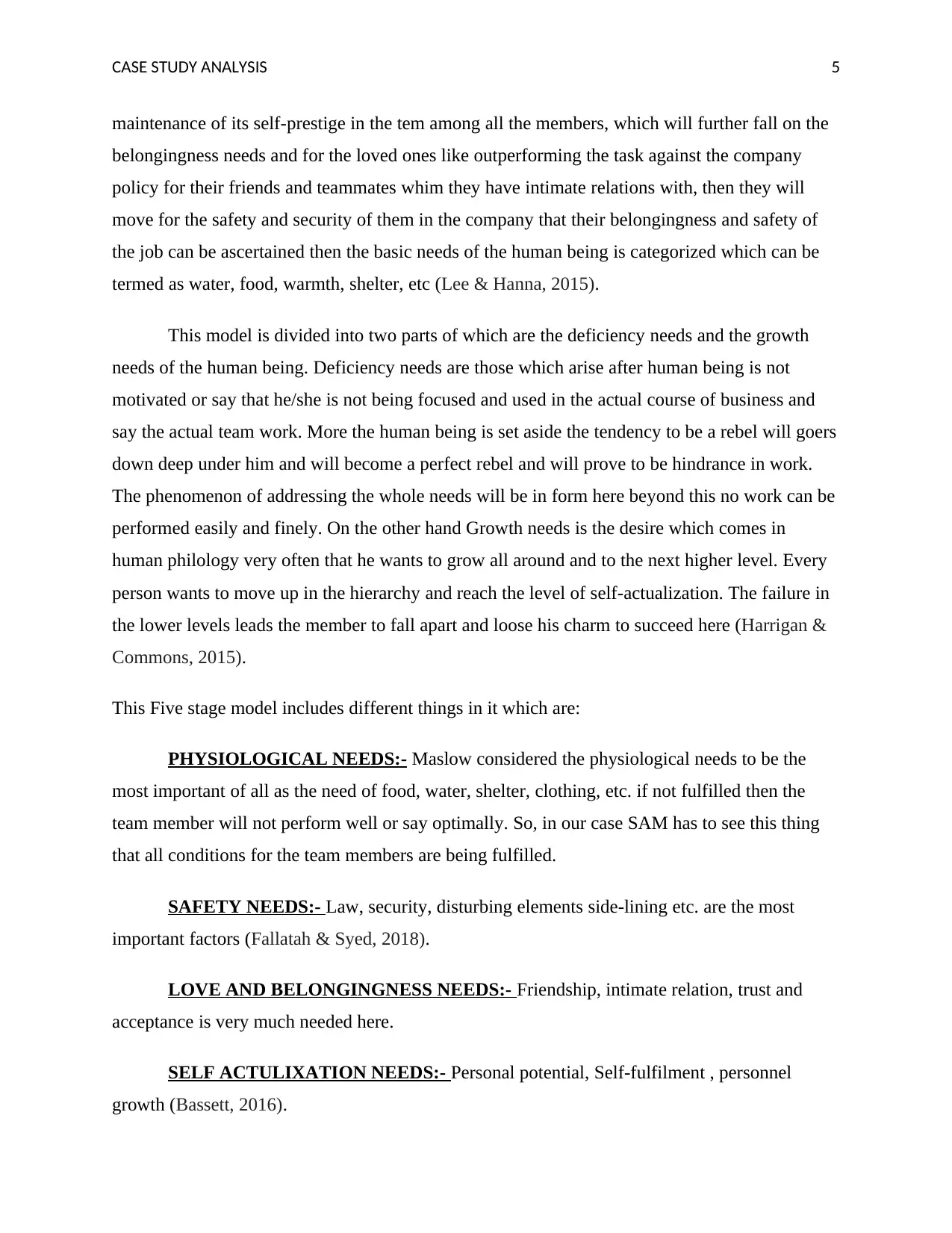
CASE STUDY ANALYSIS 5
maintenance of its self-prestige in the tem among all the members, which will further fall on the
belongingness needs and for the loved ones like outperforming the task against the company
policy for their friends and teammates whim they have intimate relations with, then they will
move for the safety and security of them in the company that their belongingness and safety of
the job can be ascertained then the basic needs of the human being is categorized which can be
termed as water, food, warmth, shelter, etc (Lee & Hanna, 2015).
This model is divided into two parts of which are the deficiency needs and the growth
needs of the human being. Deficiency needs are those which arise after human being is not
motivated or say that he/she is not being focused and used in the actual course of business and
say the actual team work. More the human being is set aside the tendency to be a rebel will goers
down deep under him and will become a perfect rebel and will prove to be hindrance in work.
The phenomenon of addressing the whole needs will be in form here beyond this no work can be
performed easily and finely. On the other hand Growth needs is the desire which comes in
human philology very often that he wants to grow all around and to the next higher level. Every
person wants to move up in the hierarchy and reach the level of self-actualization. The failure in
the lower levels leads the member to fall apart and loose his charm to succeed here (Harrigan &
Commons, 2015).
This Five stage model includes different things in it which are:
PHYSIOLOGICAL NEEDS:- Maslow considered the physiological needs to be the
most important of all as the need of food, water, shelter, clothing, etc. if not fulfilled then the
team member will not perform well or say optimally. So, in our case SAM has to see this thing
that all conditions for the team members are being fulfilled.
SAFETY NEEDS:- Law, security, disturbing elements side-lining etc. are the most
important factors (Fallatah & Syed, 2018).
LOVE AND BELONGINGNESS NEEDS:- Friendship, intimate relation, trust and
acceptance is very much needed here.
SELF ACTULIXATION NEEDS:- Personal potential, Self-fulfilment , personnel
growth (Bassett, 2016).
maintenance of its self-prestige in the tem among all the members, which will further fall on the
belongingness needs and for the loved ones like outperforming the task against the company
policy for their friends and teammates whim they have intimate relations with, then they will
move for the safety and security of them in the company that their belongingness and safety of
the job can be ascertained then the basic needs of the human being is categorized which can be
termed as water, food, warmth, shelter, etc (Lee & Hanna, 2015).
This model is divided into two parts of which are the deficiency needs and the growth
needs of the human being. Deficiency needs are those which arise after human being is not
motivated or say that he/she is not being focused and used in the actual course of business and
say the actual team work. More the human being is set aside the tendency to be a rebel will goers
down deep under him and will become a perfect rebel and will prove to be hindrance in work.
The phenomenon of addressing the whole needs will be in form here beyond this no work can be
performed easily and finely. On the other hand Growth needs is the desire which comes in
human philology very often that he wants to grow all around and to the next higher level. Every
person wants to move up in the hierarchy and reach the level of self-actualization. The failure in
the lower levels leads the member to fall apart and loose his charm to succeed here (Harrigan &
Commons, 2015).
This Five stage model includes different things in it which are:
PHYSIOLOGICAL NEEDS:- Maslow considered the physiological needs to be the
most important of all as the need of food, water, shelter, clothing, etc. if not fulfilled then the
team member will not perform well or say optimally. So, in our case SAM has to see this thing
that all conditions for the team members are being fulfilled.
SAFETY NEEDS:- Law, security, disturbing elements side-lining etc. are the most
important factors (Fallatah & Syed, 2018).
LOVE AND BELONGINGNESS NEEDS:- Friendship, intimate relation, trust and
acceptance is very much needed here.
SELF ACTULIXATION NEEDS:- Personal potential, Self-fulfilment , personnel
growth (Bassett, 2016).
⊘ This is a preview!⊘
Do you want full access?
Subscribe today to unlock all pages.

Trusted by 1+ million students worldwide

CASE STUDY ANALYSIS 6
Here SAM has to look on all the physiological aspects to get down the team together.
Conclusion
According to the given case Sam will be more suitable if he follows the Mc. George
theory of X and Y inside the team as a manager because all the conditions are favourable for that
particular theory. Sam should go with this theory only as the team members are showing attitude
in very disliking way that they are least interested in job and wants to quit it so the Theory X the
authorities will work here.
Here SAM has to look on all the physiological aspects to get down the team together.
Conclusion
According to the given case Sam will be more suitable if he follows the Mc. George
theory of X and Y inside the team as a manager because all the conditions are favourable for that
particular theory. Sam should go with this theory only as the team members are showing attitude
in very disliking way that they are least interested in job and wants to quit it so the Theory X the
authorities will work here.
Paraphrase This Document
Need a fresh take? Get an instant paraphrase of this document with our AI Paraphraser
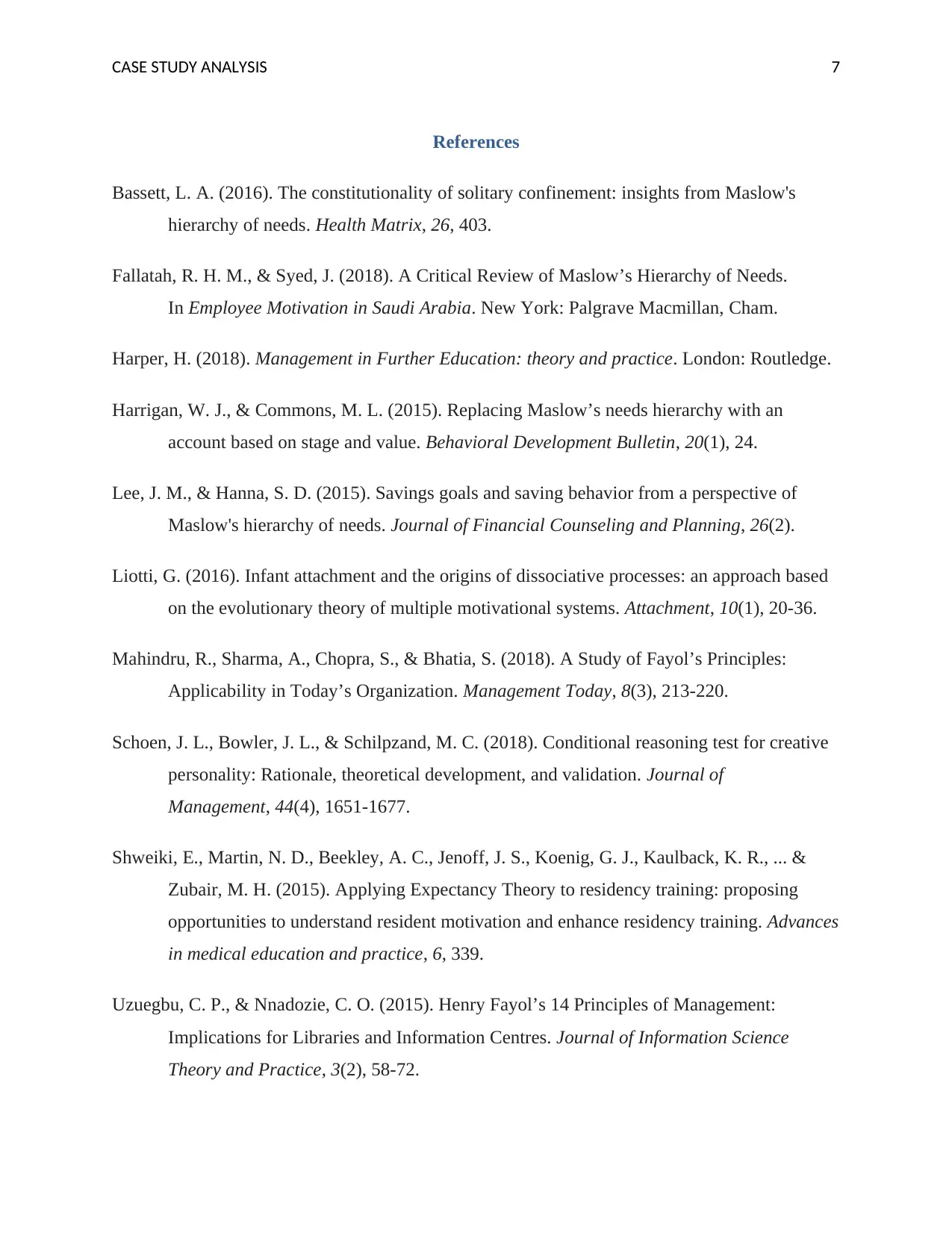
CASE STUDY ANALYSIS 7
References
Bassett, L. A. (2016). The constitutionality of solitary confinement: insights from Maslow's
hierarchy of needs. Health Matrix, 26, 403.
Fallatah, R. H. M., & Syed, J. (2018). A Critical Review of Maslow’s Hierarchy of Needs.
In Employee Motivation in Saudi Arabia. New York: Palgrave Macmillan, Cham.
Harper, H. (2018). Management in Further Education: theory and practice. London: Routledge.
Harrigan, W. J., & Commons, M. L. (2015). Replacing Maslow’s needs hierarchy with an
account based on stage and value. Behavioral Development Bulletin, 20(1), 24.
Lee, J. M., & Hanna, S. D. (2015). Savings goals and saving behavior from a perspective of
Maslow's hierarchy of needs. Journal of Financial Counseling and Planning, 26(2).
Liotti, G. (2016). Infant attachment and the origins of dissociative processes: an approach based
on the evolutionary theory of multiple motivational systems. Attachment, 10(1), 20-36.
Mahindru, R., Sharma, A., Chopra, S., & Bhatia, S. (2018). A Study of Fayol’s Principles:
Applicability in Today’s Organization. Management Today, 8(3), 213-220.
Schoen, J. L., Bowler, J. L., & Schilpzand, M. C. (2018). Conditional reasoning test for creative
personality: Rationale, theoretical development, and validation. Journal of
Management, 44(4), 1651-1677.
Shweiki, E., Martin, N. D., Beekley, A. C., Jenoff, J. S., Koenig, G. J., Kaulback, K. R., ... &
Zubair, M. H. (2015). Applying Expectancy Theory to residency training: proposing
opportunities to understand resident motivation and enhance residency training. Advances
in medical education and practice, 6, 339.
Uzuegbu, C. P., & Nnadozie, C. O. (2015). Henry Fayol’s 14 Principles of Management:
Implications for Libraries and Information Centres. Journal of Information Science
Theory and Practice, 3(2), 58-72.
References
Bassett, L. A. (2016). The constitutionality of solitary confinement: insights from Maslow's
hierarchy of needs. Health Matrix, 26, 403.
Fallatah, R. H. M., & Syed, J. (2018). A Critical Review of Maslow’s Hierarchy of Needs.
In Employee Motivation in Saudi Arabia. New York: Palgrave Macmillan, Cham.
Harper, H. (2018). Management in Further Education: theory and practice. London: Routledge.
Harrigan, W. J., & Commons, M. L. (2015). Replacing Maslow’s needs hierarchy with an
account based on stage and value. Behavioral Development Bulletin, 20(1), 24.
Lee, J. M., & Hanna, S. D. (2015). Savings goals and saving behavior from a perspective of
Maslow's hierarchy of needs. Journal of Financial Counseling and Planning, 26(2).
Liotti, G. (2016). Infant attachment and the origins of dissociative processes: an approach based
on the evolutionary theory of multiple motivational systems. Attachment, 10(1), 20-36.
Mahindru, R., Sharma, A., Chopra, S., & Bhatia, S. (2018). A Study of Fayol’s Principles:
Applicability in Today’s Organization. Management Today, 8(3), 213-220.
Schoen, J. L., Bowler, J. L., & Schilpzand, M. C. (2018). Conditional reasoning test for creative
personality: Rationale, theoretical development, and validation. Journal of
Management, 44(4), 1651-1677.
Shweiki, E., Martin, N. D., Beekley, A. C., Jenoff, J. S., Koenig, G. J., Kaulback, K. R., ... &
Zubair, M. H. (2015). Applying Expectancy Theory to residency training: proposing
opportunities to understand resident motivation and enhance residency training. Advances
in medical education and practice, 6, 339.
Uzuegbu, C. P., & Nnadozie, C. O. (2015). Henry Fayol’s 14 Principles of Management:
Implications for Libraries and Information Centres. Journal of Information Science
Theory and Practice, 3(2), 58-72.

CASE STUDY ANALYSIS 8
Voxted, S. (2017). 100 years of Henri Fayol. mrev management revue, 28(2), 256-274.
Voxted, S. (2017). 100 years of Henri Fayol. mrev management revue, 28(2), 256-274.
⊘ This is a preview!⊘
Do you want full access?
Subscribe today to unlock all pages.

Trusted by 1+ million students worldwide
1 out of 9
Related Documents
Your All-in-One AI-Powered Toolkit for Academic Success.
+13062052269
info@desklib.com
Available 24*7 on WhatsApp / Email
![[object Object]](/_next/static/media/star-bottom.7253800d.svg)
Unlock your academic potential
Copyright © 2020–2025 A2Z Services. All Rights Reserved. Developed and managed by ZUCOL.





